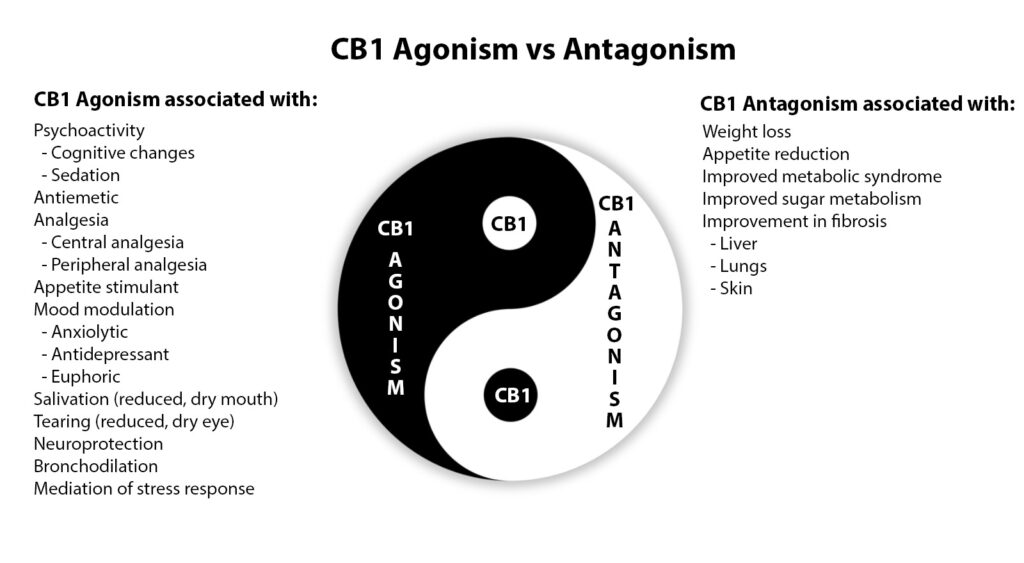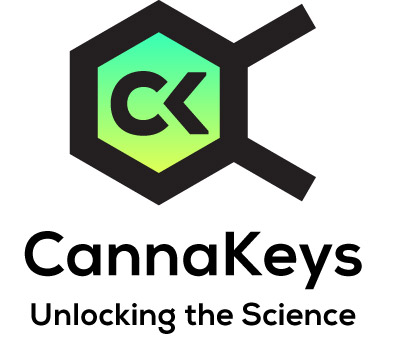An antagonist binds to a CB1 receptor and stops or slows the expected response an agonist at the same site would induce (see below).

CB1 Agonism vs Antagonism
CB1 agonism and CB1 antagonism tend to induce opposing effects. For instance, THC is an agonist at CB1 and can cause a dose-dependent euphoria, while THCV and antagonist at CB1 can induce a dose-dependent dysphoria.
CB1 Antagonism Associated Effects
High ECS-based tone or excessive CB1 signaling has been associated with obesity, metabolic syndrome, diabetes (type-2), diabetes-induced cardiomyopathy, and fibrosis of the liver and the lungs (G. Dörnyei et al., 2023).1 More specifically, in people with visceral fat deposits (deep in the abdomen), excessive CB1 signaling increases caloric intake and decreases energy expenditure, which may be corrected by CB1 antagonism (J. Tam et al., 2017).2
Weight loss (J. Després et al., 2005)3 The use of CB1 antagonism (or prebiotics) decreased intestinal ECS-tone(Giulio G. Muccioli et al., 2010).4
Appetite reduction (CB1 antagonism modulates appetite hormones, e.g., leptin, ghrelin) (J. Tam et al.,5 2017; S. E. O’Sullivan et al., 2021).6
Improved metabolic syndrome (I. Merroun et al., 2013; Dörnyei et al., 2023)7
Improved glycemic control via SIRT1 (J. Liu et al., 2019)8
Improved diabetes-induced cardiomyopathy (M. Rajesh et al., 2012)9
Improved pulmonary and liver fibrosis (CB1 antagonism has therapeutic potential)(R. Cinar et al., 2020).10
Duchenne muscular dystrophy (CB1 antagonism mitigated locomotor deficits in animals) (F. Iannotti et al., 2018).11
CB1 Antagonists
THCV is a CB1 antagonist with a mean Ki of ~84nM using data from 5 trials (J. McPartland et al., 2015).12
Rimonabant (a.k.a. SR-141716) was approved in the EU to treat obesity (2006). However, while effective in reducing signs and symptoms associated with obesity, it was later withdrawn (2008) due to psychiatric adverse effects (A. Samat et al., 2008).13
The synthetic cannabinoid AM4113 is a CB1 receptor antagonist associated with reducing food intake (N. Cluny et al., 2011).14
Dual CB1 antagonists and CB2 agonists include the synthetic cannabinoids GW405833 and AM1710 (A. Dhopeshwarkar et al., 2017).15
Hemopressin (derived from the α1 chain of hemoglobin) is an antagonist at CB1 (A. Heimann et al., 2007).16
Endnotes:
1. Dörnyei, Gabriella, Zsolt Vass, Csilla Berta Juhász, György L. Nádasy, László Hunyady, and Mária Szekeres. 2023. “Role of the Endocannabinoid System in Metabolic Control Processes and in the Pathogenesis of Metabolic Syndrome: An Update” Biomedicines 11, no. 2: 306.
2. Tam J, Szanda G, Drori A, Liu Z, Cinar R, Kashiwaya Y, Reitman ML, Kunos G. Peripheral cannabinoid-1 receptor blockade restores hypothalamic leptin signaling. Mol Metab. 2017 Oct;6(10):1113-1125.
3. Després JP, Golay A, Sjöström L; Rimonabant in Obesity-Lipids Study Group. Effects of rimonabant on metabolic risk factors in overweight patients with dyslipidemia. N Engl J Med. 2005 Nov 17;353(20):2121-34.
4. Giulio G Muccioli, Damien Naslain, Fredrik Backhed, Christopher S. Reigstad, Didier M .Lambert, Nathalie M. Delzenne, and Patrice D. Cani. (2010). The endocannabinoid system links gut microbiota to adipogenesis. Molecular Systems Biology 6:392.
5. Tam J, Szanda G, Drori A, Liu Z, Cinar R, Kashiwaya Y, Reitman ML, Kunos G. Peripheral cannabinoid-1 receptor blockade restores hypothalamic leptin signaling. Mol Metab. 2017 Oct;6(10):1113-1125.
6. O’Sullivan, Saoirse Elizabeth, Andrew S. Yates, and Richard K. Porter. 2021. “The Peripheral Cannabinoid Receptor Type 1 (CB1) as a Molecular Target for Modulating Body Weight in Man” Molecules 26, no. 20: 6178.
7. Merroun I, Sánchez-González C, Martínez R, López-Chaves C, Porres JM, Aranda P, Llopis J, Galisteo M, Zarzuelo A, Errami M, López-Jurado M. Novel effects of the cannabinoid inverse agonist AM 251 on parameters related to metabolic syndrome in obese Zucker rats. Metabolism. 2013 Nov;62(11):1641-50.
Dörnyei, Gabriella, Zsolt Vass, Csilla Berta Juhász, György L. Nádasy, László Hunyady, and Mária Szekeres. 2023. “Role of the Endocannabinoid System in Metabolic Control Processes and in the Pathogenesis of Metabolic Syndrome: An Update” Biomedicines 11, no. 2: 306.
8. Liu, J., Godlewski, G., Jourdan, T., Liu, Z., Cinar, R., Xiong, K., & Kunos, G. (2019). Cannabinoid-1 Receptor Antagonism Improves Glycemic Control and Increases Energy Expenditure Through Sirtuin-1/Mechanistic Target of Rapamycin Complex 2 and 5’Adenosine Monophosphate-Activated Protein Kinase Signaling. Hepatology (Baltimore, Md.), 69(4), 1535–1548.
9. Mohanraj Rajesh, Sándor Bátkai, Malek Kechrid, Partha Mukhopadhyay, Wen-Shin Lee, Béla Horváth, Eileen Holovac, Resat Cinar, Lucas Liaudet, Ken Mackie, György Haskó, Pál Pacher; Cannabinoid 1 Receptor Promotes Cardiac Dysfunction, Oxidative Stress, Inflammation, and Fibrosis in Diabetic Cardiomyopathy. Diabetes 1 March 2012; 61 (3): 716–727.
10. Cinar R, Iyer MR, Kunos G. The therapeutic potential of second and third generation CB1R antagonists. Pharmacol Ther. 2020 Apr;208:107477.
11. Iannotti FA, Pagano E, Guardiola O, Adinolfi S, Saccone V, Consalvi S, Piscitelli F, Gazzerro E, Busetto G, Carrella D, Capasso R, Puri PL, Minchiotti G, Di Marzo V. Genetic and pharmacological regulation of the endocannabinoid CB1 receptor in Duchenne muscular dystrophy. Nat Commun. 2018 Sep 27;9(1):3950.
12. McPartland JM, Duncan M, Di Marzo V, Pertwee RG. Are cannabidiol and Δ(9) -tetrahydrocannabivarin negative modulators of the endocannabinoid system? A systematic review. Br J Pharmacol. 2015 Feb;172(3):737-53.
13. Samat A, Tomlinson B, Taheri S, Thomas GN. Rimonabant for the treatment of obesity. Recent Pat Cardiovasc Drug Discov. 2008 Nov;3(3):187-93.
14. Cluny NL, Chambers AP, Vemuri VK, Wood JT, Eller LK, Freni C, Reimer RA, Makriyannis A, Sharkey KA. The neutral cannabinoid CB₁ receptor antagonist AM4113 regulates body weight through changes in energy intake in the rat. Pharmacol Biochem Behav. 2011 Jan;97(3):537-43.
15. Amey Dhopeshwarkar, Natalia Murataeva, Alex Makriyannis, Alex Straiker and Ken Mackie (2017). Two Janus Cannabinoids. Journal of Pharmacology and Experimental Therapeutics, 360 (2) 300-311.
16. Heimann AS, Gomes I, Dale CS, Pagano RL, Gupta A, de Souza LL, Luchessi AD, Castro LM, Giorgi R, Rioli V, Ferro ES, Devi LA. Hemopressin is an inverse agonist of CB1 cannabinoid receptors. Proc Natl Acad Sci U S A. 2007 Dec 18;104(51):20588-93.

